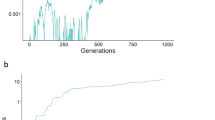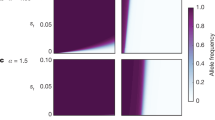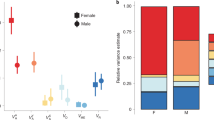Abstract
SEVERAL workers1,2 have shown the numerical equality of two sexes (that is, a 1 : 1 sex ratio) to be selectively favoured in relation to the parental effort involved in the rearing of offsprings to maturity. More recently, Kalmus and Smith3 have argued in support of the adaptive superiority of this ratio on the basis of such considerations as those of hybridity, recombination potential and the level of inbreeding as influenced by sex ratio variations. However, their arguments are not valid in general and at best seem to apply only to the monogamous species. In fact, widely deviant sex ratios are reported to occur in the natural populations of both polygamodiœcious and gynodiœcious species4,5, and Lewis5 has suggested that sex ratio adjustments frequently through a preponderance of females help ensure reproductive economy combined with the maintenance of certain hybridity optima in such species. In a few theoretical examples analysed by Shaw6, such adaptive changes were examined in the presence of certain specific sex-ratio factors. In this note a model of differential selection for an autosomal recessive in the two sexes is utilized to show that maximum levels of heterozygosity (say 0.50 where gene frequencies p, q = ½) could be attained with variable sex ratios, a result in disagreement with the view of Kalmus and Smith3.
This is a preview of subscription content, access via your institution
Access options
Subscribe to this journal
Receive 51 print issues and online access
$199.00 per year
only $3.90 per issue
Buy this article
- Purchase on Springer Link
- Instant access to full article PDF
Prices may be subject to local taxes which are calculated during checkout
Similar content being viewed by others
References
Fisher, R. A., The Genetical Theory of Natural Selection, 272 (Clarendon Press, Oxford, 1930).
Bodmer, W. F., and Edwards, A. F. W., Ann. Human Genet., 24, 239 (1960).
Kalmus, H., and Smith, C. A. B., Nature, 186, 1004 (1960).
Pauley, S. S., and Mennel, G. F., Minnesota Forestry Notes, 55, 1 (1957).
Lewis, D., Biol. Revs., 17, 46 (1942).
Shaw, R. F., Genetics, 43, 149 (1958).
Watson, G. S., Evolution, 14, 256 (1960).
Mather, K., Nature, 145, 484 (1940).
Grant, V., Cold Spring Harbor Symp. Quant. Biol., 23, 337 (1958).
Author information
Authors and Affiliations
Rights and permissions
About this article
Cite this article
JAIN, S. Sex Ratios under Natural Selection. Nature 200, 1340–1341 (1963). https://doi.org/10.1038/2001340c0
Issue Date:
DOI: https://doi.org/10.1038/2001340c0
This article is cited by
-
Seed production and sex ratio in anemophilous plants
Heredity (1972)
Comments
By submitting a comment you agree to abide by our Terms and Community Guidelines. If you find something abusive or that does not comply with our terms or guidelines please flag it as inappropriate.



